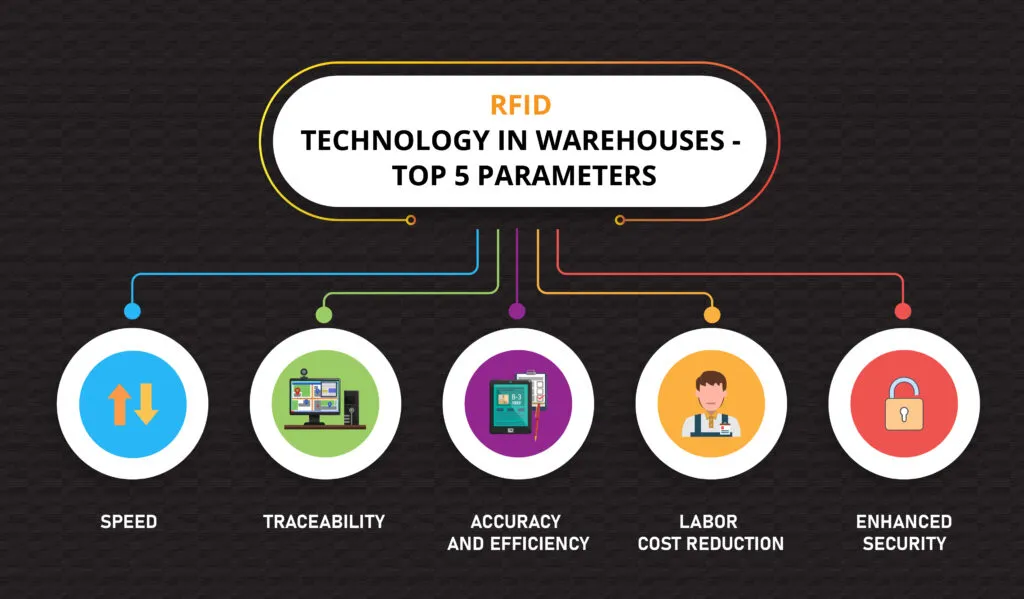
RFID technology has transformed inventory management systems in warehouses, offering numerous advantages over traditional barcode systems. With RFID Inventory management, warehouses can achieve enhanced inventory accuracy, real-time tracking, and streamlined operations. Unlike barcodes, RFID tags can be read without direct line-of-sight, enabling faster and more efficient inventory scans.
`Additionally, RFID technology allows for simultaneous scanning of multiple items, reducing time and labor costs. By implementing mobile RFID solutions, warehouses can further optimize their inventory management processes, ensuring timely and accurate stock replenishment.
This guide will delve into the essence of RFID inventory management, its significance in warehouses, cost considerations, and its benefits and drawbacks compared to traditional barcode systems. Additionally, we will explore how mobile RFID solutions ensure inventory accuracy and optimization.

RFID (Radio Frequency Identification) is a wireless technology that uses electromagnetic fields to automatically identify, and track tags attached to objects. An RFID system comprises of three main components: RFID tags, RFID readers, and an antenna.

RFID technology enables automatic and accurate data capture, which is critical for efficient inventory management.
RFID technology has become indispensable in modern warehouses due to its ability to significantly enhance inventory management processes. Here's why RFID is crucial:
Also Read: Top Benefits of RFID Technology | Propel Apps

RFID provides real-time data, drastically reducing human error compared to manual entry or barcode scanning. This accuracy ensures that inventory counts are precise, leading to better stock management and reduced discrepancies.
RFID systems can read multiple tags simultaneously without direct line-of-sight, speeding up the inventory process. This efficiency is crucial for large warehouses with vast quantities of items.
With RFID, each item can be tracked from its entry into the warehouse to its exit, offering complete traceability. This is vital for quality control, recalls, and ensuring regulatory compliance.
Automation of inventory processes means fewer human resources are needed, which reduces labor costs and allows workers to focus on more strategic tasks.
RFID can help in preventing theft and loss by providing real-time alerts for unauthorized movement of items.
RFID inventory management involves using RFID technology to track and manage inventory throughout the supply chain. The system includes RFID tags, readers, and software that captures and analyzes data. This system allows for real-time inventory tracking, which leads to improved inventory accuracy, reduced stockouts and overstock situations, and better decision-making based on accurate data.
Implementing an RFID inventory management system typically involves tagging all inventory items with RFID tags. These tags are then scanned by RFID readers as they move through various points in the warehouse, providing instant updates to the inventory management software. This real-time data allows for more effective inventory control, improved logistics, and streamlined operations.
Now that we have got a good overview of RFID inventory management and its key benefits in a warehouse setup, we will now move forward to understand the cost implications of having a good RFID inventory management system in a warehouse.
The cost of implementing an RFID inventory management system can vary widely depending on several factors:
Overall, a comprehensive RFID inventory management system for a mid-sized warehouse might cost anywhere from $20,000 to $100,000 or more.
While both RFID and barcodes are used for inventory management, they differ significantly in terms of technology and application:
RFIDBarcodesTechnologyUses radio waves to read data from tags. Can read multiple tags simultaneously and does not require line-of-sight.Use optical scanning to read printed barcodes. Requires line-of-sight and can typically read one barcode at a time.Speed and EfficiencyCan scan hundreds of tags per second, making it much faster and more efficient for large-scale inventory management.Slower as each barcode must be individually scanned.Data StorageTags can store more information compared to barcodes, including serial numbers, batch numbers, and other detailed data.Limited to storing basic information such as product codes.DurabilityTags are generally more durable and can be embedded within products, making them less susceptible to damage.Can be easily damaged or worn, leading to scanning issues.Difference Between RFID and Barcodes
Mobile RFID solutions play a crucial role in enhancing inventory accuracy and optimization. These solutions integrate mobile RFID readers with software applications, allowing warehouse staff to conduct inventory checks on the go. The key benefits include:
In the above context, Propel Apps, a leading digital transformation company has developed a mobile inventory management solution that leverages the power the power of your existing ERP systems like Oracle EBS, Oracle Cloud and SAP to offer a seamless inventory management experience. By utilizing the full spectrum of auto-identification technologies, such as Barcodes, RFID and Optical Character Recognition (OCR), your warehouse staff can effortlessly record every physical inventory movement in Oracle or SAP in real-time. What's more? This solution even works offline, ensuring that there is no loss in productivity irrespective of your connectivity status. To know more about this solution and its cutting-edge features to enhance your warehouse productivity, schedule a call with us for a demo.
RFID technology offers significant advantages for inventory management in warehouses, including improved accuracy, efficiency, and security. While the initial cost and complexity can be higher compared to traditional barcode systems, the long-term benefits make RFID a compelling choice for modern inventory management. Mobile RFID solutions further enhance these benefits by providing flexibility and real-time data, ensuring optimal inventory accuracy and optimization.

7 Tips for Inventory Management with Barcode Scanning (propelapps.com)